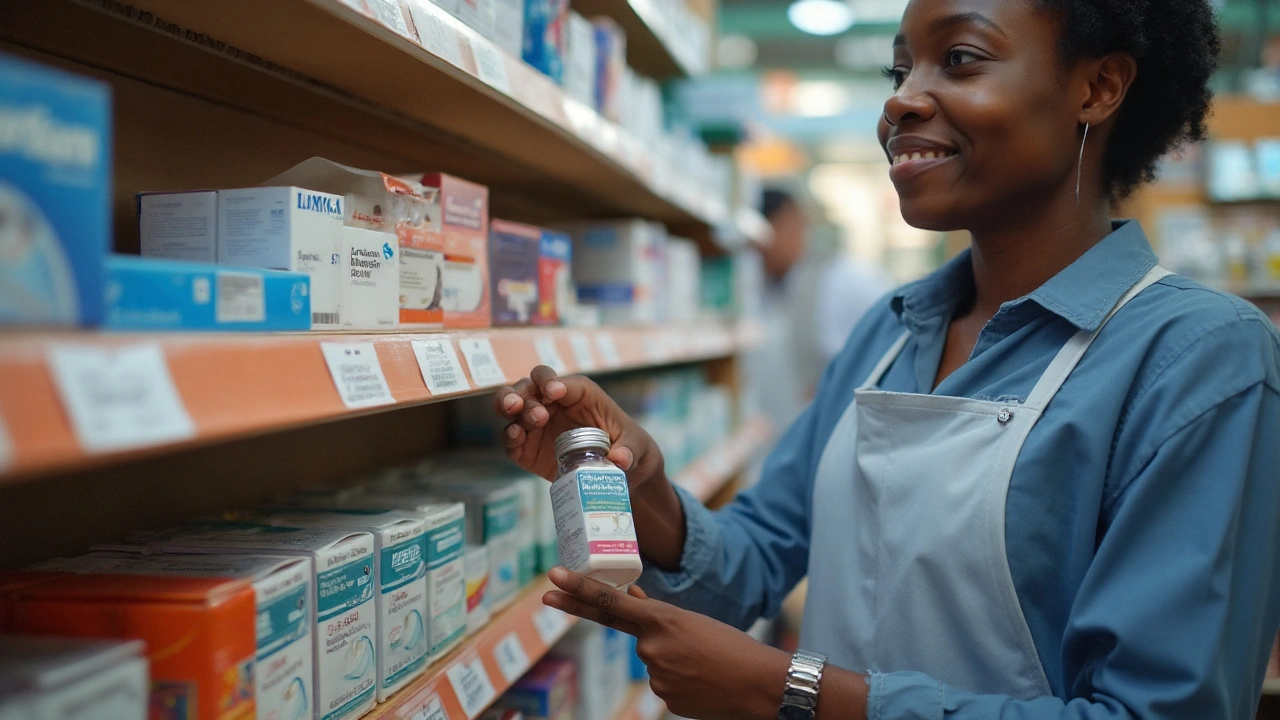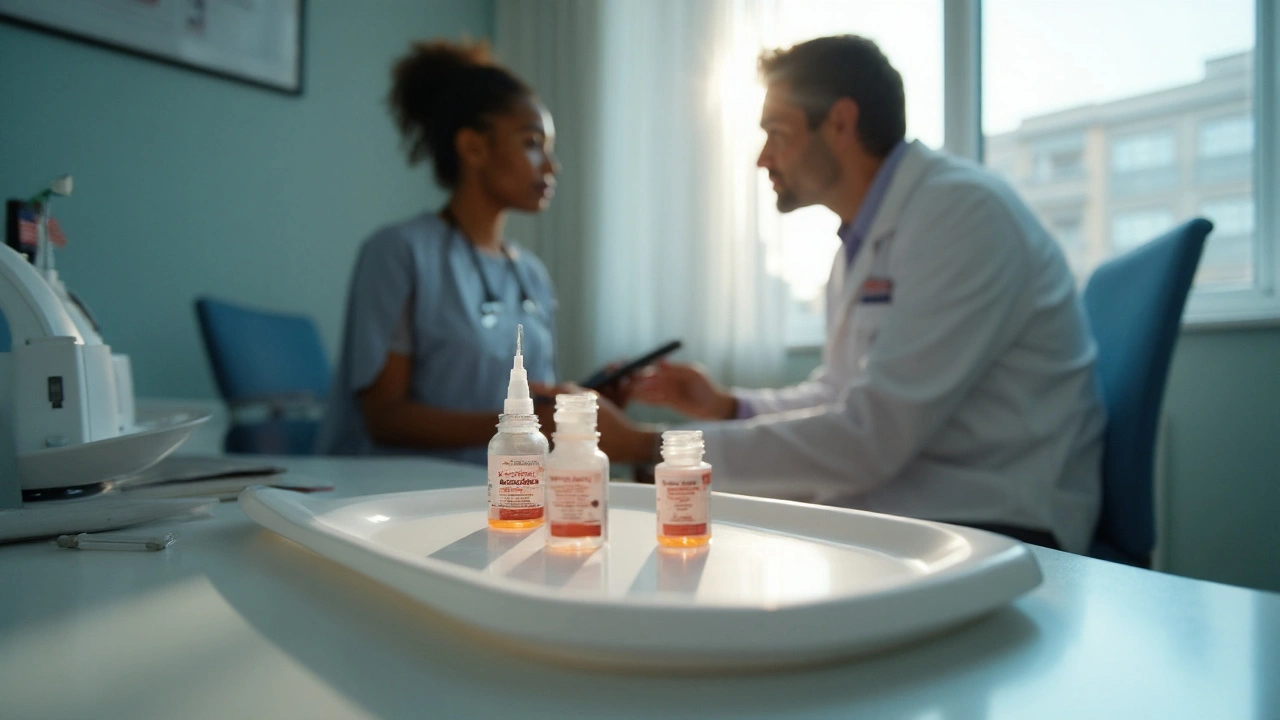Glaucoma Eye‑Drop Selector Quiz
Lumigan is a prostaglandin F2α analogue used to lower intraocular pressure (IOP) in patients with open‑angle glaucoma or ocular hypertension. Its active ingredient, bimatoprost, increases uveoscleral outflow, delivering a 25‑30% IOP reduction in most users.
Quick Take
- Lumigan offers strong IOP reduction but may cause darkening of iris.
- Latanoprost and travoprost are cheaper prostaglandin analogues with similar efficacy.
- Brimonidine works via a different pathway (α‑2 agonist) and is useful for combination therapy.
- Carbonic anhydrase inhibitors (e.g., dorzolamide) lower fluid production.
- Beta‑blockers such as timolol are the oldest class; great for patients needing multiple mechanisms.
How Lumigan Works
The prostaglandin pathway is the cornerstone of modern glaucoma treatment. By binding to FP receptors in the ciliary body, bimatoprost remodels extracellular matrix, allowing fluid to exit the eye more easily. This mechanism is shared with other prostaglandin analogues but varies slightly in receptor affinity, which explains the subtle differences in side‑effect profiles.
Key Attributes of Lumigan
- Potency: 0.01% ophthalmic solution; one drop daily at bedtime.
- Onset of action: 4‑6 hours, peak effect at 8‑12 hours.
- Duration: 24‑hour IOP control.
- Adverse events: conjunctival hyperemia, eyelash growth, iris pigmentation.
- Cost: Premium brand price, often covered by Australian PBS with a co‑payment.
Common Alternatives
Below are the most frequently prescribed drops that compete with Lumigan. Each belongs to a different therapeutic class, which matters when patients have contraindications or need additive effects.
Latanoprost (Xalatan) is a prostanoid FP receptor agonist with a 0.005% concentration. It reduces IOP by 25‑30% and is the most widely used prostaglandin analogue worldwide.
Travoprost (Travatan) is another FP‑receptor agonist, available in a preservative‑free formulation for patients sensitive to benzalkonium chloride.
Tafluprost (Taflotan) is a synthetic prostaglandin analogue that offers similar efficacy with a marginally lower rate of hyperemia.
Brimonidine (Alphagan) is an α‑2 adrenergic agonist. By decreasing aqueous humor production, it reduces IOP about 20‑25% and can be combined with prostaglandins for additive effect.
Dorzolamide (Trusopt) belongs to the carbonic anhydrase inhibitor (CAI) class. It blocks fluid production in the ciliary processes, delivering a modest 15‑20% IOP drop.
Timolol is a non‑selective beta‑blocker that reduces aqueous humor formation; often paired with prostaglandins when a single‑drop regimen isn’t enough.
Omidenepag isopropyl (Eyiku) is an EP2 receptor agonist, a newer class that bypasses FP receptors entirely. Early trials show comparable IOP reductions with a different side‑effect spectrum.
Side‑Effect Landscape
Understanding tolerability helps decide which drop fits a patient’s lifestyle. Prostanoid drugs (Lumigan, Latanoprost, Travoprost, Tafluprost) share common issues: mild redness, eyelash lengthening, and possible iris darkening. Brimonidine can cause ocular allergy and systemic fatigue, while beta‑blockers may affect heart rate and respiratory function. CAIs like dorzolamide sometimes cause a metallic taste. Omidenepag’s notable adverse event is superficial punctate keratitis in a small subset.

Cost and Accessibility in Australia
Government subsidies (PBS) cover most branded prostaglandins, but the tiered co‑payment differs. Generic latanoprost and travoprost are typically cheaper than brand‑name Lumigan. Brimonidine and timolol remain low‑cost, especially in generic form. Omidenepag, being new, is priced higher and limited to specialist prescription.
Comparison Table
| Drug | Class | Typical IOP Reduction | Key Side‑Effects | Cost (AU$) per 30drops |
|---|---|---|---|---|
| Lumigan | Prostaglandin analog | 25‑30% | Hyperemia, iris darkening, eyelash growth | ~45 |
| Latanoprost | Prostaglandin analog | 25‑30% | Redness, occasional iris change | ~30 |
| Travoprost | Prostaglandin analog | 25‑30% | Redness, mild ocular irritation | ~35 |
| Tafluprost | Prostaglandin analog | 24‑28% | Less hyperemia, rare iris change | ~40 |
| Brimonidine | α‑2 agonist | 20‑25% | Allergy, dry mouth, fatigue | ~25 |
| Dorzolamide | Carbonic anhydrase inhibitor | 15‑20% | Metallic taste, stinging | ~20 |
| Timolol | Beta‑blocker | 20‑25% | Bradycardia, bronchospasm | ~15 |
| Omidenepag | EP2 agonist | 24‑28% | Keratic precipitates, mild pain | ~55 |
Choosing the Right Drop for You
Pick a medication based on three pillars: effectiveness, tolerance, and systemic safety.
- Effectiveness: If the goal is maximal IOP reduction, prostaglandin analogues (Lumigan, latanoprost, travoprost) are first‑line. Lumigan’s slightly higher affinity for FP receptors can edge out others in resistant cases.
- Tolerability: Patients who notice darkening of iris or excess eyelash growth often switch to latanoprost or preservative‑free travoprost. \n
- Systemic considerations: Those with asthma, COPD, or heart block should avoid beta‑blockers like timolol. Brimonidine’s central nervous system effects make it unsuitable for people prone to depression.
Combination therapy (e.g., prostaglandin + timolol) is common when a single agent cannot achieve target IOP. A step‑wise approach-start with a prostaglandin, then add a beta‑blocker or CAI-matches most Australian treatment algorithms.
Practical Tips for Eye‑Drop Use
- Apply drops at bedtime; lying down reduces systemic absorption.
- Wait at least five minutes before a second medication to avoid washout.
- Store unused vials in a cool, dry place; discard after six weeks of opening.
- Report any new eyelash growth, eye redness, or visual changes to your optometrist.
Related Concepts
Understanding the broader glaucoma care landscape helps you make informed choices. Key related topics include:
- Intraocular pressure (IOP) - the primary risk factor you’re trying to control.
- Open‑angle glaucoma - the most common form treated with these drops.
- Visual field testing - monitors disease progression.
- Laser trabeculoplasty - a procedural alternative when drops fail.
- Adherence counseling - essential for long‑term success.
When to Seek Professional Advice
If you experience sudden eye pain, blurry vision, or a rapid rise in IOP despite treatment, contact your ophthalmologist immediately. These could signal an acute angle‑closure event, which requires urgent intervention.

Frequently Asked Questions
Is Lumigan more effective than latanoprost?
Clinical studies from 2023‑2024 show Lumigan provides a modest 1‑2% greater IOP reduction in patients who do not respond fully to latanoprost. The difference is statistically significant but may not be clinically relevant for everyone.
Can I use more than one glaucoma drop at the same time?
Yes. Many clinicians prescribe a prostaglandin analogue combined with a beta‑blocker or carbonic anhydrase inhibitor. Space the drops by at least five minutes to avoid dilution.
What should I do if my eyes get red after using Lumigan?
Mild redness is common and often resolves within weeks. If it persists, switch to a preservative‑free formulation like travoprost PF or discuss a change with your eye‑care professional.
Is it safe to use Lumigan while pregnant?
Animal data suggest a risk of fetal eye development issues, and the Australian Medicines Handbook advises caution. Discuss alternatives with your obstetrician and ophthalmologist.
Why does Lumigan make my eyelashes grow longer?
Bimatoprost stimulates the hair‑growth cycle in eyelash follicles, a side‑effect that has been marketed as a cosmetic benefit. The effect is reversible after stopping the medication.
How often should I replace my eye‑drop bottle?
Most ophthalmic solutions are stable for 28 days after opening. Mark the first use date on the bottle and discard any remaining solution after six weeks.
Can I switch from a branded prostaglandin to a generic version?
In Australia, generic latanoprost is widely available and considered therapeutically equivalent. Discuss with your pharmacist; bioequivalence is confirmed by the TGA.


Comments
rajendra kanoujiya
Everyone keeps pushing Lumigan as the king of prostaglandins, but the marginal extra IOP drop isn’t worth the pigment changes and eyelash drama.
September 24, 2025 at 12:42
Caley Ross
Stick with generic latanoprost if you want the same pressure control without the premium price.
September 24, 2025 at 15:20
Bobby Hartono
When you read through the whole table it becomes clear that the choice isn’t just about raw numbers.
The real world tolerability profile often decides whether a patient stays on therapy for years.
For instance, the hyperemia you get with many prostaglandins can be a deal‑breaker for someone who works in front of a camera.
On the other hand, the subtle eyelash growth that Lumigan offers has actually turned into a cosmetic perk for many people.
If you’re worried about iris darkening, you can switch to latanoprost or even a preservative‑free travoprost formulation and avoid that particular side‑effect.
Cost is another driver – generic latanoprost typically runs about a third cheaper than brand‑name Lumigan in the Australian PBS schedule.
Yet, don’t discount the value of adherence; a once‑daily drop that patients can tolerate is far more cost‑effective than a cheaper drug they quit using.
For patients with asthma or COPD, beta‑blockers like timolol are off the table, so brimonidine or a carbonic anhydrase inhibitor becomes more appropriate.
The newer EP2 agonist omidenepag shows promise, but its higher price tag and limited availability keep it as a second‑line option for now.
Combination therapy, such as adding a low‑dose beta‑blocker to a prostaglandin, can push IOP down further without dramatically increasing adverse events.
It’s also worth noting that many clinicians advise a five‑minute interval between drops to prevent wash‑out, a simple tip that improves efficacy.
In practice, I’ve seen patients who started on Lumigan switch to latanoprost after a few weeks because the redness became too conspicuous.
Conversely, some patients stay on Lumigan for years precisely because they love the thicker lashes and accept a little extra redness.
The key takeaway is to individualize therapy based on the patient’s ocular surface health, systemic comorbidities, and financial circumstances.
Ultimately, no single drop is universally “best”; it’s a nuanced decision that should involve the patient in the discussion.
September 24, 2025 at 18:06
George Frengos
Thank you for the comprehensive overview; your emphasis on individualized therapy aligns well with evidence‑based guidelines. By prioritizing both efficacy and tolerability, clinicians can maximize adherence and long‑term visual outcomes. It is especially prudent to consider systemic contraindications such as asthma or bradycardia when selecting adjuncts. Your point about the five‑minute interval between drops is a practical reminder that often gets overlooked in busy practices. Overall, a balanced, patient‑centered approach remains the cornerstone of glaucoma management.
September 24, 2025 at 20:53
Jonathan S
It’s disheartening to see patients overlook the ethical responsibility of choosing a medication that doesn’t jeopardize their overall health 😊. While cost considerations are valid, compromising on safety for a cheaper drop can lead to systemic complications, especially in vulnerable populations 😔. Physicians must advocate for treatments that respect both ocular and systemic well‑being, rather than succumbing to purely financial pressures. Ignoring contraindications like asthma when prescribing beta‑blockers is simply negligent, and the long‑term burden on the healthcare system grows as a result. Let’s remember that our primary duty is to do no harm, even if it means navigating insurance hurdles or discussing alternative funding options 😇.
September 24, 2025 at 23:40
Charles Markley
From a pharmacoeconomic standpoint, the incremental cost‑effectiveness ratio (ICER) of Lumigan versus generic latanoprost fails to achieve the willingness‑to‑pay threshold in the current Australian PBS framework. The marginal gain in IOP reduction (<2 mmHg) is eclipsed by the adverse event profile, quantifiable via number‑needed‑to‑harm (NNH) analyses. Moreover, the pharmacodynamic affinity of bimatoprost for FP receptors induces off‑target melanocyte activation, precipitating iris hyperpigmentation-a phenomenon best described through the lens of melanocyte‑stem cell niche modulation. In lieu of this, a tiered therapeutic algorithm employing first‑line prostaglandin analogues, followed by adjunctive beta‑blockers or carbonic anhydrase inhibitors, optimizes both therapeutic ceiling and safety ceiling. Consequently, the judicious deployment of omidenepag as a second‑line agent should be predicated upon rigorous cost‑utility modeling rather than premature market enthusiasm.
September 25, 2025 at 02:26